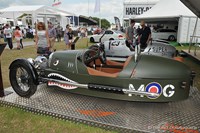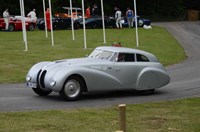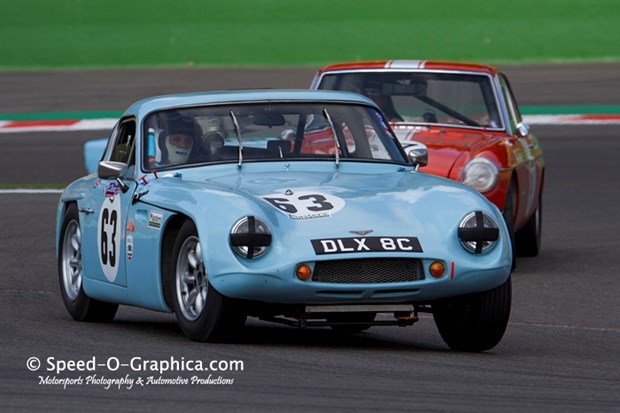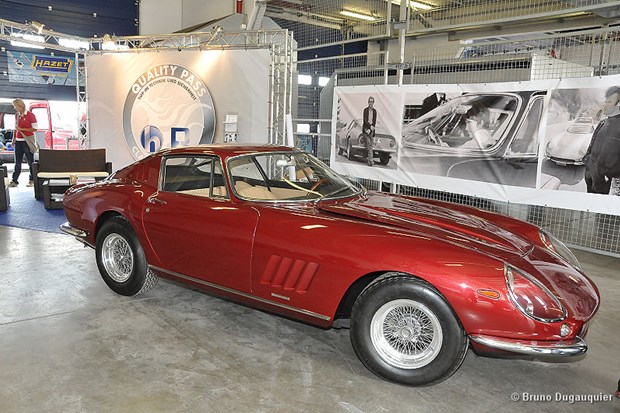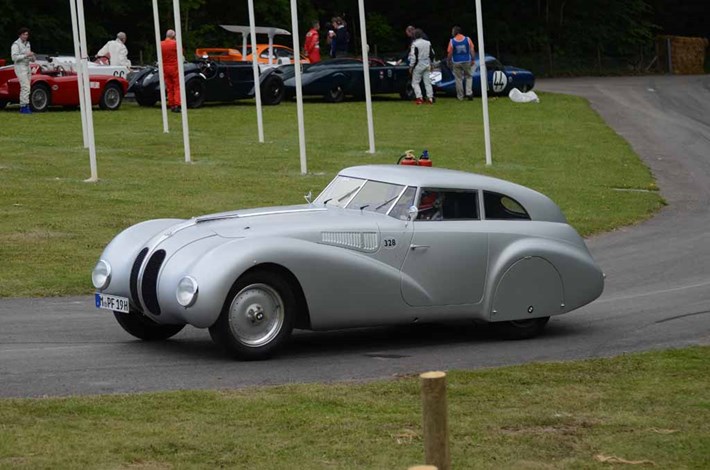
By Simon & Janet Wright.

Celebrations for the 4th of July, American Independence day came early to England this year. The Goodwood Festival of Speed saw a large contingence of American cars and drivers descend on the West Sussex hill to celebrate 100 years of the famous Indianapolis 500 race. This was the largest celebration of the great race outside of the United States, with over 40 rarely seen and significant cars on display, and 33 lined up for a run up the hill, the same number of cars that actually start the Indianapolis race. The cars covered the entire 100 years, with a 1911 Marmon Wasp on static display from the Indianapolis Motor Speedway Hall of fame, right up to 2011 race winner Dan Wheldon running in a Target Chip Ganassi Dallara Honda. As a special honour, Lord March was given some of the original 3.2 million bricks which made up the original circuit, hence the name "The Brick yard", to lay across the start line at Goodwood. These will remain as a permanent fixture to the course. This is similar to the yard of bricks which still consists of the start line at Indianapolis.
The Pre-war Indianapolis cars included several interesting vehicles, including a 1913 Peugeot L45 running complete with a riding mechanic on board. The 1931 Duesenberg 'Cummins Diesel Special' made a smokey run up the hill, being the only car to compete the 500 mile race without a single stop. Eddie Cheever gave this car a run along with Anthony Fairbaim. There was a nice selection of front engined Roadsters covering the 1941 to 1963 era before the first of the rear engined cars arrived in 1961 with the Cooper - Climax T54, The Rear-engined Revolution class also saw the Lotus Pratt & Whitney 56 STP Special in its day glow pink colour scheme, quietly whine its way up the course driven by legend Parnelli Jones. The Winged Wonders class had cars from 1970- 1979 and included the Johnny Rutherford 1976 500 winning McLaren Offenhauser M16C, which was the last win for the Offenhauser power plant. Bringing the field right up to date were the Modern Indy Cars including examples built by Chaparral, Penske, Eagle, March, Lotus, Panoz and Dallara.
By far the most unusual car from Indianapolis was the 1964 S-C Corp'n Hurst Floor Shifter Special. Designed by Smokey Yunick, the car was a sidecar design with the driver sitting in a separate body next to the main chassis which holds the Offenhauser engine. The car never achieved anything as it was crashed backwards into the wall during practice for the 1964 Indianapolis 500 by Bobby Johns and never raced at Indianapolis again, but resides in the Museum.
The other unusual visitors from America were a pair of Chaparral Can-Am cars. The 2E from the 1966 inaugural Can-Am championship had an adjustable high rear wing attached to the rear hubs, to generate down force directly to the rear wheels. Operated by a foot pedal, the wing could be flattened out for maximum speed down the straight. The car won at Laguna Seca driven by Phil Hill.
This was followed up by another revolutionary design idea, the Chaparral 2J Fan Car in 1970. Two fans at the rear of the car were powered by a separate 45hp snowmobile engine and sucked the car down on to the track to improve down force. Driven by the current World Champion Jackie Stewart, it always set fast qualifying times but did not win a race due to a series of mechanical failures. At the end of the 1970 season it was banned as it was felt that the fans constituted a moveable aerodynamic device which had been banned by the FIA.
Each year a major sculpture is assembled outside Goodwood House representing a key significant anniversary. This year it was a representation of the Jaguar E-Type sports car, celebrating its 50th birthday. Made from Steel tubes, it measured 28 metres high, used ½ a kilometre of steel and weighed 175 tonnes, the equivalent of 135 E-Type Jags. There were also a range of historic E-Type Jaguars taking part in the event.
Besides all the demonstration runs by cars up the hill, there is also a competition held over the weekend, with the fastest 10 competitors going into a shoot out competition on the Sunday afternoon. Jonny Milner had been setting the pace all weekend in his hill climb special Toyota Celica, but on Sunday afternoon, Dan Collins, driving the Lotus 88B twin chassis Grand Prix car set a blistering time of 48.52 seconds to win the shoot out. Milner was the last to run, but pushed a little too hard through Molecomb corner, getting on to the grass. Even with the slight mistake, his time of 48.99 seconds was good enough for second.
At the top of the hill was a separate Rally stage, with a very large entry of classic and more modern rally cars. The emphasis was on some of the Group B rally supercars from the 1980s as it was 25 years ago that the Group B cars were banned. A rare example of a Group B car was the Citroen BX which was barely developed when the category was banned. The 1.67 mile stage was designed by Hannu Mikkola.
On the side lawn outside the stables, the Cartier Style et Luxe concours d'elegance showcased the best of classic cars in various categories. Overall winner was the 1951 Ferrari 340 America of David Cottingham. The other category winners were the 1931 Bentley 4 ½ litre Supercharged Roadster of William Ainscough, best Boat tailed Beauties, 1937 Tatra T77 of Kees Smith won the Pre-War Streamlined Specials class , the 1961 Renault 3 won the People Power class and finally the Comeback Kids award was taken by Maarten de Buijn's 1999 Spyker Silvestris V8 prototype.
Photos de Bruno
Les photos de Bruno


